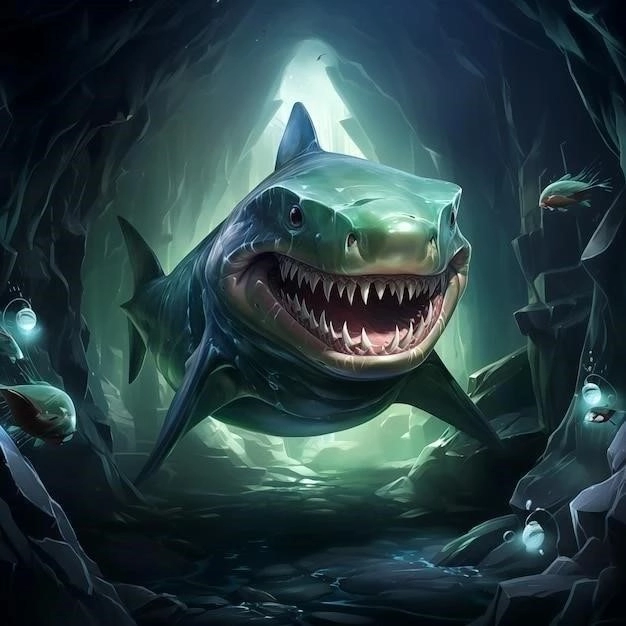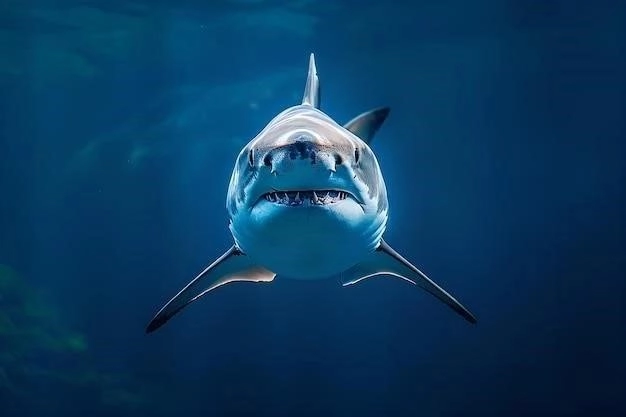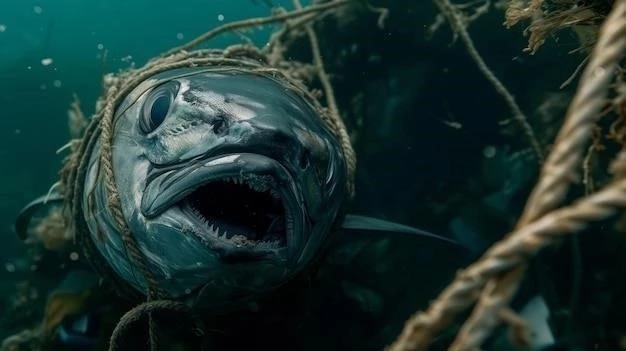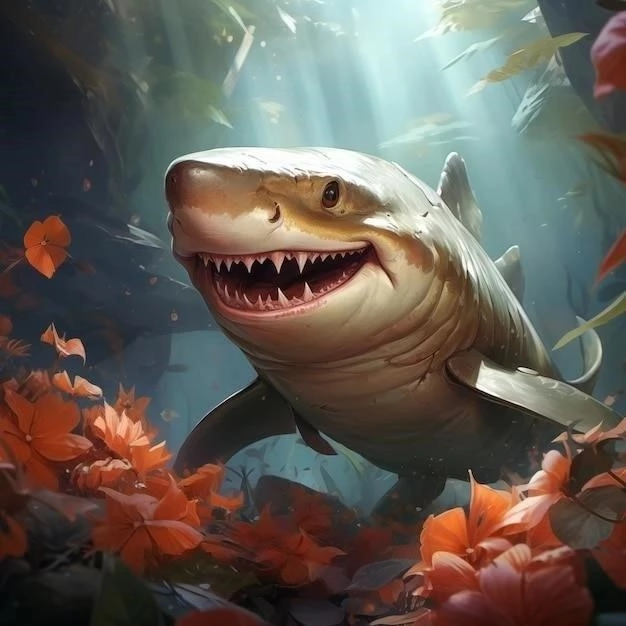The Goblin Shark: A Deep Dive into a Living Fossil
The goblin shark (Mitsukurina owstoni) is a rare and fascinating species of deep-sea shark. This elusive creature is often referred to as a “living fossil” as it is the sole surviving member of the ancient Mitsukurinidae family, with a lineage dating back over 125 million years.
Physical Characteristics
The goblin shark is immediately recognizable due to its striking and unusual physical characteristics. Perhaps its most remarkable feature is its elongated, flattened snout, or rostrum, which resembles a blade-like protrusion. This distinctive snout, comprising nearly one-third of the shark’s total body length, houses a unique sensory organ known as the ampullae of Lorenzini. This network of electroreceptors, appearing as small pores on the snout’s surface, enables the goblin shark to detect the faint electrical fields produced by prey animals, even in the darkness of the deep sea.

Another striking characteristic of the goblin shark is its protrusible jaw. Unlike most shark species with fixed jaws, the goblin shark possesses a jaw that can extend rapidly forward, much like a slingshot, to capture prey. This jaw protrusion is facilitated by a complex system of ligaments and cartilages, allowing for a sudden, snatching motion. When retracted, the goblin shark’s jaws rest underneath its snout, giving it an almost beak-like appearance.
Adding to its unusual appearance are the goblin shark’s teeth. It has numerous rows of long, slender, and slightly curved teeth that are both sharp and needle-like, resembling fangs. These teeth are ideal for spearing and securing soft-bodied prey, such as squid and fish. The goblin shark’s coloration also sets it apart from other shark species. Its body typically exhibits a pale pink or pinkish-gray hue, which becomes more pronounced after death. This coloration is not due to pigmentation but rather to the translucency of its skin. The goblin shark’s dermis, the layer of skin beneath the scales, is semi-transparent, allowing the blood vessels beneath to be visible, giving it a pinkish cast. This unusual characteristic is thought to be an adaptation to its deep-sea environment, where light penetration is minimal.
Further distinguishing features of the goblin shark include its flabby body, small eyes, and relatively small fins. Its soft, flaccid body is indicative of a sluggish lifestyle, relying on stealth and ambush predation rather than speed. This is supported by the goblin shark’s poorly developed myotomes, the blocks of muscle responsible for swimming. Its small eyes, while functional, suggest a reduced reliance on vision in the deep-sea environment where light is scarce. In terms of size, goblin sharks can reach impressive lengths. Adult females are typically larger than males, with recorded lengths of up to 12.2 feet (372 cm). Adult males, on the other hand, have been observed to reach lengths of up to 8.66 feet (264 cm).
Habitat and Distribution
The goblin shark is a deep-sea dweller, inhabiting the dimly lit depths of the ocean where sunlight barely penetrates. These sharks are typically found at depths ranging from 890 to 4,300 feet (270 to 1,300 meters), residing primarily along the upper to middle continental slopes, submarine canyons, and seamounts. These environments provide the ideal combination of darkness, prey availability, and suitable water pressure for this unique species.
Goblin sharks exhibit a wide geographic distribution, inhabiting temperate and tropical waters around the globe. They have been documented in all major oceans, including the Atlantic, Pacific, and Indian Oceans. However, due to their deep-water habitat and elusive nature, sightings are relatively rare and often sporadic.
While goblin sharks have been reported from various locations worldwide, there appear to be some areas where encounters are more frequent. The waters off the coast of Japan, particularly in Suruga Bay, have yielded a significant number of goblin shark specimens, leading some researchers to believe this region may serve as a primary habitat or breeding ground. Other areas where goblin sharks have been observed with relative frequency include the Gulf of Mexico, the eastern coast of Australia, and the waters surrounding New Zealand.
The goblin shark’s preference for deep-water environments and its wide geographic distribution contribute to its elusive nature. Its presence in these remote and often inaccessible habitats makes it challenging for researchers to study its behavior, ecology, and population dynamics in detail. Most of what we know about goblin sharks is derived from specimens accidentally caught in deep-water fishing nets or observed during remotely operated underwater vehicle (ROV) explorations. As technology advances and deep-sea exploration continues, we can expect to gain a more comprehensive understanding of the goblin shark’s distribution, habitat preferences, and ecological role in these fascinating and vital ecosystems.
Hunting and Diet
The goblin shark, an inhabitant of the lightless depths, has evolved a unique and efficient hunting strategy adapted to its environment and prey. Unlike some shark species that rely on speed and agility to pursue their quarry, the goblin shark employs a more passive ambush tactic, relying on stealth and a lightning-fast jaw extension to capture its prey.
Central to the goblin shark’s hunting prowess is its remarkable jaw structure. When a potential prey item, such as a fish, squid, or crustacean, is detected, the goblin shark launches a swift and unexpected attack. Its jaws, normally resting beneath its elongated snout, shoot forward with incredible speed and force, creating a suction-like effect that draws the unsuspecting prey into its mouth. This rapid jaw protrusion, likened to a slingshot in its speed and mechanism, allows the goblin shark to snatch prey from a distance, compensating for its relatively slow swimming speed.
The goblin shark’s diet, reflecting its deep-sea habitat, consists primarily of a variety of benthic and pelagic organisms. Among its preferred prey are teleost fishes, which constitute a significant portion of its diet. Cephalopods, such as squid and octopus, are also commonly consumed by goblin sharks. These soft-bodied creatures, abundant in the deep sea, provide a readily available source of nutrition. Crustaceans, including crabs and shrimp, supplement the goblin shark’s diet, offering a source of protein and essential nutrients.
While direct observations of goblin shark hunting behavior in the wild are scarce due to their elusive nature and deep-water habitat, stomach content analyses of captured specimens have provided valuable insights into their dietary preferences. The presence of deep-sea fishes, squid, and crustaceans in their stomachs confirms their role as opportunistic predators within their ecosystem. Furthermore, the goblin shark’s elongated snout, equipped with ampullae of Lorenzini, plays a crucial role in prey detection, allowing it to sense the faint electrical fields generated by prey animals concealed in the darkness of the deep sea.

Unique Adaptations

The goblin shark possesses a suite of unique adaptations that enable it to thrive in the extreme environment of the deep sea. These adaptations are a testament to the power of natural selection, shaping this species over millennia to survive in a realm of perpetual darkness, crushing pressure, and scarce food resources.

One of the most striking adaptations of the goblin shark is its protrusible jaw. This highly specialized feeding mechanism allows the goblin shark to compensate for its relatively slow swimming speed and effectively capture prey in the vast expanse of the deep sea. The jaws, normally resting beneath the elongated snout, can be rapidly projected forward, creating a suction-like effect that draws prey into the mouth. This adaptation is crucial in an environment where prey encounters are infrequent and ambush predation is the most effective hunting strategy.
Further enhancing its hunting prowess is the goblin shark’s highly developed electrosensory system. Its elongated snout is densely packed with ampullae of Lorenzini, specialized sensory organs that detect the faint electrical fields generated by the muscle contractions of prey animals. This adaptation is particularly advantageous in the deep sea, where light penetration is minimal and prey animals often rely on camouflage to avoid detection. The goblin shark’s electrosensory system allows it to “see” potential prey, even in complete darkness, giving it a significant advantage in this challenging environment.
The goblin shark’s pale pinkish-gray coloration, while seemingly unusual, is another adaptation to its deep-sea habitat. This coloration is due to the translucency of its skin, allowing the blood vessels beneath to be visible. While not providing camouflage in the traditional sense, this adaptation may help to break up its silhouette in the dimly lit depths, making it more difficult for predators or prey to detect.

Its flabby body and poorly developed musculature, while seemingly disadvantageous, are also adaptations to its deep-sea lifestyle. In an environment where energy conservation is paramount, a streamlined body and powerful muscles are not essential for survival. The goblin shark’s reduced muscle mass reduces its metabolic rate, allowing it to conserve energy in a habitat where food is scarce.
Reproduction and Life Cycle
The reproductive biology and life cycle of the goblin shark, like many aspects of its ecology, remain shrouded in mystery due to its elusive nature and the challenges of studying animals that inhabit the deep sea. However, limited information gleaned from captured specimens and opportunistic observations has provided some insights into these fascinating aspects of the goblin shark’s life history.

Goblin sharks are believed to be ovoviviparous, meaning that their eggs develop and hatch internally, with the young sharks receiving nourishment from a yolk sac within the mother’s body. This reproductive strategy, common among deep-sea sharks, allows for the development of relatively large and well-developed offspring, enhancing their chances of survival in the challenging deep-sea environment.
The exact gestation period for goblin sharks is unknown, but it is believed to be lengthy, potentially lasting several months to a year or more. This extended gestation is characteristic of many deep-sea species, reflecting the slower metabolic rates and extended life cycles often observed in cold, deep-water environments. Litter sizes for goblin sharks are also unknown, as pregnant females are rarely encountered.
Upon birth, goblin shark pups are believed to be relatively large, measuring perhaps two to three feet in length. These miniature versions of their parents possess the same distinctive features, including the elongated snout and protrusible jaws, equipping them for life in the deep sea. Little is known about the early life stages of goblin sharks, including their growth rates, feeding habits, and social interactions.

The age at which goblin sharks reach sexual maturity remains a mystery, as does their lifespan. However, based on their slow growth rates, deep-sea habitat, and the longevity observed in other deep-sea shark species, it is speculated that goblin sharks may have a prolonged lifespan, potentially reaching several decades or more.
Conservation Status
Assessing the conservation status of deep-sea species like the goblin shark presents significant challenges due to the logistical constraints of studying populations in these remote and often inaccessible environments. Data deficiency, stemming from limited observations, sparse catch records, and the inherent difficulties of monitoring populations at great depths, hinders comprehensive assessments of their vulnerability to threats and the development of effective conservation measures.
The International Union for Conservation of Nature (IUCN), the global authority on the conservation status of species, categorizes the goblin shark as “Least Concern” on its Red List of Threatened Species. This designation, however, should be interpreted with caution given the aforementioned data limitations. The “Least Concern” category does not imply that the goblin shark is not facing conservation risks, but rather that there is insufficient evidence to definitively assess its extinction risk.
Despite the absence of conclusive data on population trends, several potential threats to goblin shark populations have been identified. Deep-water fishing, particularly bottom trawling, poses a significant risk to goblin sharks and other deep-sea species. Bottom trawls, large weighted nets that are dragged along the seabed, can indiscriminately capture goblin sharks as bycatch, leading to incidental mortality. The expansion of deep-water fishing into new areas, driven by the demand for seafood and other marine resources, could exacerbate this threat.
Climate change, specifically ocean warming and acidification, also has the potential to impact goblin shark populations, although the extent of these impacts is currently unknown. Alterations in water temperature and chemistry could affect the distribution, abundance, and availability of prey species upon which goblin sharks rely, potentially disrupting their delicate ecological balance.










